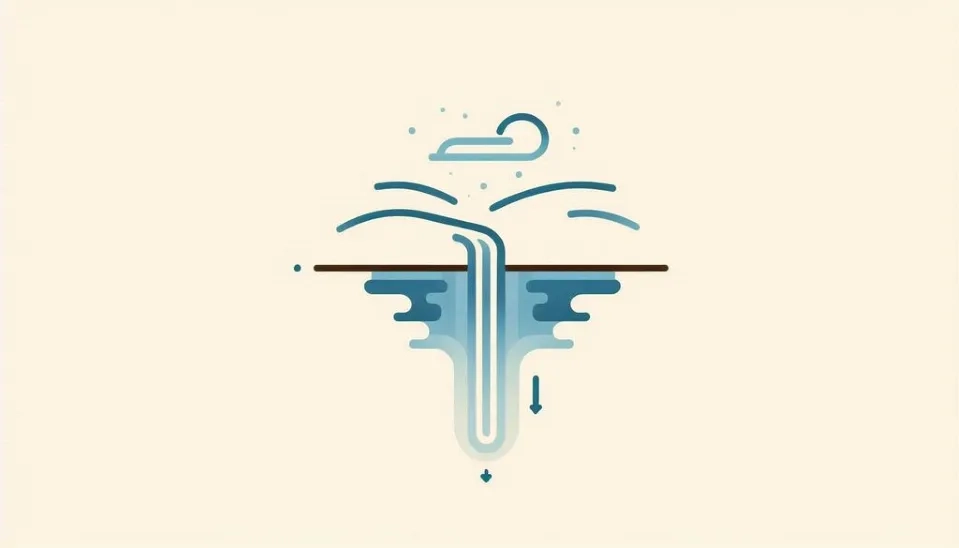
As time passes, humans realize the importance of water and its resources more and more. According to recent research, only 2.5% of global water is fresh and about 30% of it belongs to groundwater (USGS, 2022); this means that only a small portion of freshwater, less than 1%, is available to be used through groundwater flows and its interaction with surface water. It must be known that groundwater flow interaction has a significant impact on the temperature and ecosystem of the lakes (Safaie et al., 2017). Therefore, it is urgent to expand our knowledge about the definition of groundwater flow and its impacts on surface water quality. The water, flowing through the porous media of the ground, defines groundwater, which is the world’s biggest accessible source of freshwater to fulfill human water demands (Scanlon et al. 2023). As the structure of the ground layers differs in every direction, aquifer systems and their governing equations change as well. Therefore, the different types of aquifer systems need to be distinguished for scientists. Another important aspect of groundwater flow is its changes in time; meaning, if the groundwater flow properties change in the study time scale, the flow will not be steady anymore and the changes should be considered.
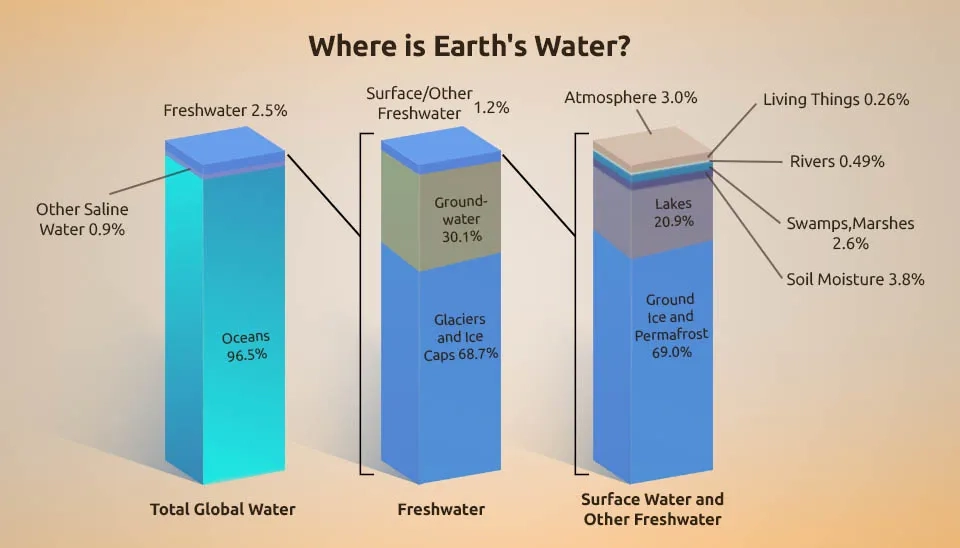
In the next step, the interaction between groundwater and surface water (GW–SW) becomes significant. This interaction causes many changes in the properties of the water table, and it also controls variable precipitation rates over time, which effectively sustains river flows during droughts and evaporation times in areas with shallow water tables. Therefore, knowledge of GW-SW interactions is essential for scientists and hydrologists to effectively manage and optimize water resources. By understanding this matter, estimating the impact of climate change or land use on water quality and ecosystem health will become much easier (Banerjee et al. 2023).
1. What Does Groundwater Flow Mean?
Groundwater is freshwater from rain or melted ice and snow that soaks into the soil (water seepage) and stores in the pores between soil particles and rocks. It can stay underground for many years, or it can flow to the surface and help fill rivers, streams, lakes, ponds, and wetlands. Groundwater can also come to the surface as a spring or be pumped from a well and become available to be used for human needs (Graaf et al. 2017). Groundwater is stored in the tiny open spaces between rock and sand, soil, and gravel. The capacity of the soil to hold water depends on the size of the soil particles. Layers of well-sorted soil (such as sand) tend to hold more water than layers of poorly sorted soil containing different-sized particles. This is because smaller particles settle in the spaces between larger ones, reducing the amount of open space that can hold water. Porosity (the capacity to hold water) is also affected by the shape of rock particles. Round particles will pack more tightly than particles with sharp edges. Material with angular-shaped edges has more open space and can hold more water. When the pores are connected, the soil is permeable, resulting in the flowing of stored water through pores, which creates the groundwater flow. Hence, a good groundwater source is one with high permeability as well as high porosity (Kamann et al. 2007).
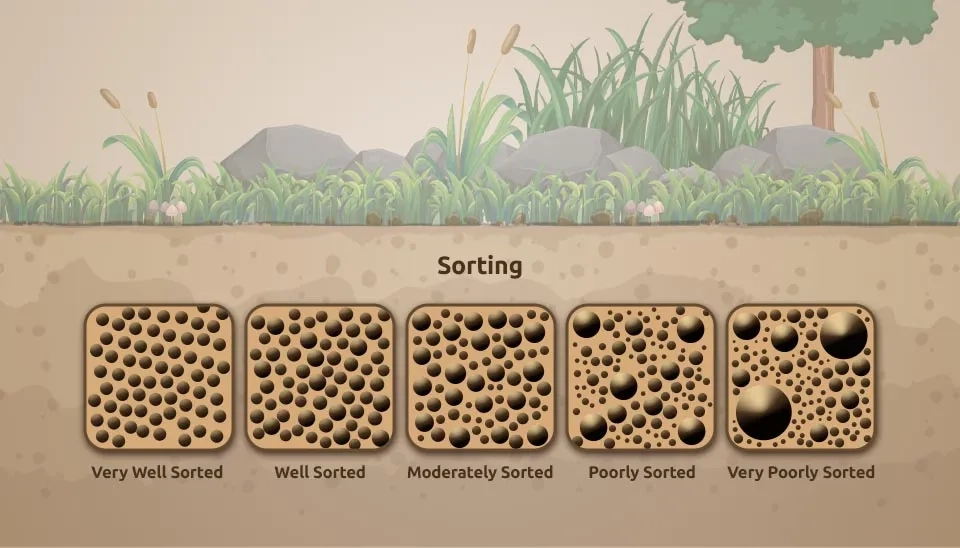
Groundwater is found in two zones. The unsaturated zone, exactly under the surface, contains water and air in the porous media. The saturated zone is a zone in which all the pores and rock fractures are filled with water; it is below the unsaturated zone. The top of the saturated zone is called the water table (Younger et al. 2009).
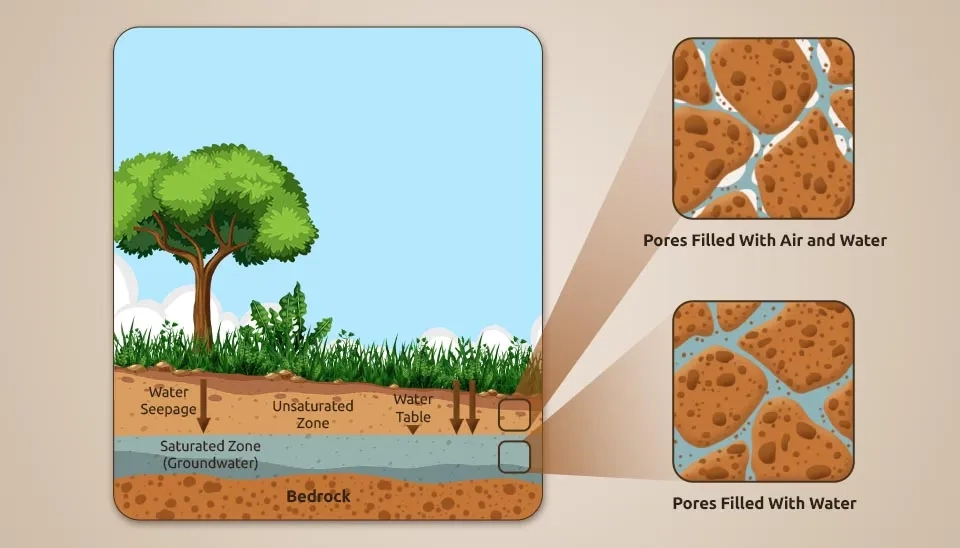
Groundwater can become depleted if we use it at a faster rate than it can refill itself. The replenishment of aquifers by precipitation is called recharging (USGS, 2018).
2. Different Aquifer Systems
An aquifer is a body of porous sediment or rock that is filled with groundwater. The process by which groundwater enters the aquifer is through precipitation that drips into the soil. Groundwater can move through aquifers and resurface through springs and wells. A common misunderstanding about aquifers is that they are underground rivers or lakes. While groundwater can seep into or out of aquifers due to its porous nature, it cannot move fast enough to flow like a river. The rate at which groundwater moves through an aquifer varies depending on the rock’s permeability. There are two general types of aquifers: confined and unconfined (Putranto et al., 2019).
2.1. Unconfined Aquifer
An aquifer that is not overlain by any confining layer but has a confining layer at its bottom is called an unconfined aquifer. It is normally exposed to the atmosphere and the upper portion is partially saturated with water. The upper surface of saturation or the water table, is under atmospheric pressure (Almanza Tovar et al., 2020).
2.2. Confined Aquifer
A confined or artesian aquifer is a type of aquifer that is overlain as well as underlain by confining layers. This results in the aquifer holding its water under pressure. If the aquifer has a higher outcrop laterally than the ground surface, there will be positive hydrostatic pressure to create conditions for a flowing well, which is named an artesian well. Water from such wells comes to the surface without any mechanical aids or pumping. The imaginary level up to which the water will rise is called the piezometric surface (Darsono et al. 2023).
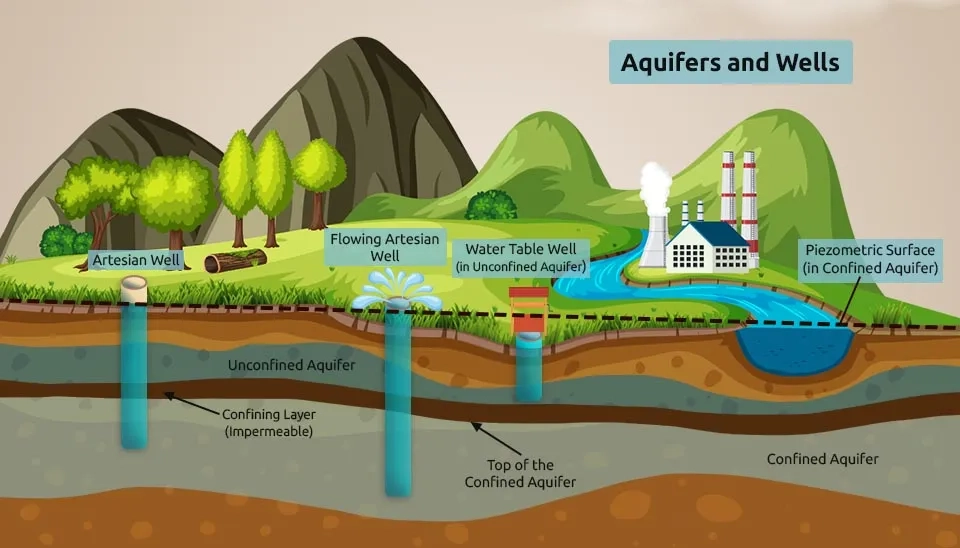
3. Steady and Unsteady Groundwater Flows
As the study time scale changes the governing equations of the flows, it’s necessary to consider flow changes over the time scale. Generally, there are two types of flow in fluids. The water under the ground is also a fluid and has two different flow types called steady and unsteady flow, which are introduced in the following paragraphs.
3.1. Steady Flow in Confined and Unconfined Aquifer
Under the conditions of a steady flow in both the “Confined and Unconfined Aquifer”, the level of groundwater in the unconfined aquifer and piezometric level of groundwater in the confined aquifer remain constant over time and will not change. It needs to be highlighted that when the rate of discharge of groundwater is equal to the rate of recharge of groundwater, then a steady flow in both confined and unconfined aquifers can be observed. In addition, there can be observed a linear slope or gradient to the “piezometric surface” if there is a steady flow in a confined aquifer. Another situation of steady flow is when the time scale of the study is short enough so that the changes in the flow will not affect the governing equations and can be ignored (Strack, 2017).
3.2. Unsteady Flow in Confined and Unconfined Aquifer
In both the confined and unconfined aquifer, an unsteady flow refers to the condition where the quantity of groundwater flowing per second does not remain constant. Furthermore, from various research, it can be observed that an unsteady flow is considered a “transient phenomenon.” As time passes, the unsteady flow in both the confined and unconfined aquifer can become zero or steady flow. On the other hand, in this type of flow, the rate of groundwater recharge is not equal to the rate of groundwater discharge. Moreover, when the study wants to analyze the groundwater flow for a long period, the changes in the flow cannot be neglected at all (Threadgill et al. 2020).
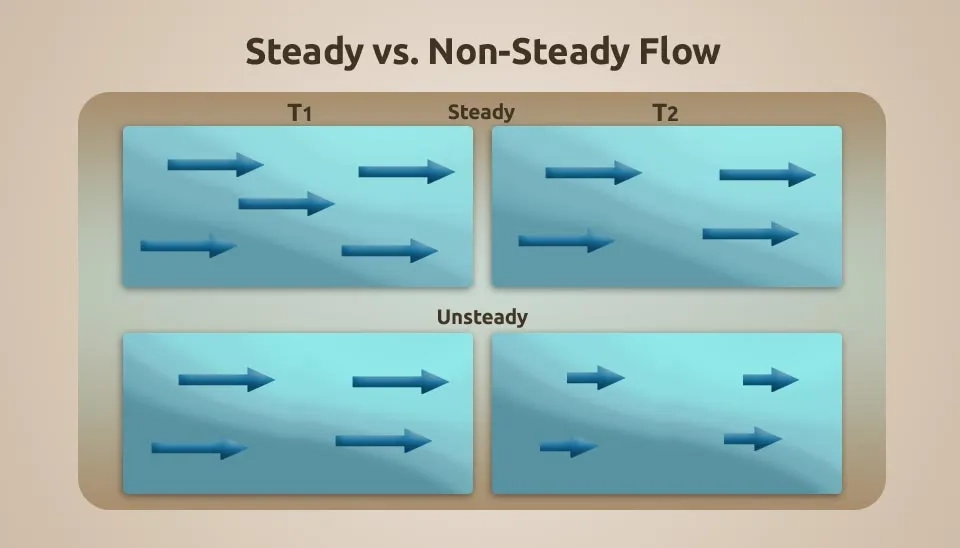
4. Groundwater Interaction with Surface Water
The interaction of the two important parts of the water cycle, groundwater (GW) and surface water (SW), was considered irrelevant in the past but was examined and quantified for a long time. With time, their profound interdependency has been explored. Groundwater flow interaction with surface water takes place in various ways in all landscapes of the earth (Winter et al. 1995). Recently, researchers have focused more on the fact that surface water and groundwater resources are interconnected and must be managed together to sustain watershed resources and ecosystem health (Essaid et al. 2017).
The interface between groundwater and surface water occurs where the water table intersects the land surface. This means that the groundwater-surface water interface occurs in streams and rivers, lakes, wetlands, and the ocean. When the water table drops, wetlands and lakes can go dry. Perched lakes on low-permeability sediments can persist above the water table, but most lakes receive groundwater discharge or combine groundwater discharge and recharge. Even for a water body as vast as the ocean, groundwater discharge has been increasingly recognized as an important component of the hydrologic cycle (Moore, 2010). Thus, groundwater discharge is a key to the sustainability of all surface water resources.
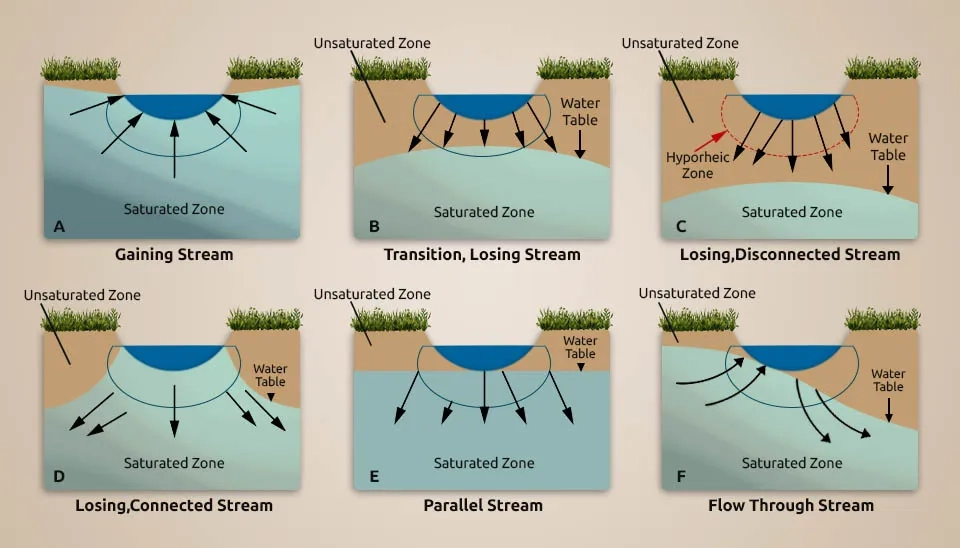
The interface can involve fluxes in both directions. Lakes and wetlands are known to both gain and lose water to groundwater. Perched lakes can lose groundwater through low-permeability lake beds. Groundwater discharge to lakes typically occurs along the shore based on flow system concepts but can be gaining (receiving flux from groundwater) on one shore and losing (recharging flux to groundwater) on another. Both gain and loss can occur along different reaches of the stream.
Groundwater–surface water interaction is important for both physical and chemical fluxes in the hydrologic cycle. Groundwater and surface water systems have commonly been studied separately, making it difficult to quantify the fluxes. Nonetheless, there is increasing recognition of the importance of understanding how this interface influences hydrologic budgets, geochemical cycles, ecosystems, and global change (Conant et al., 2019).
5. Conclusion
In this article, our purpose was to explain groundwater flow from different points of view and it results in understanding how groundwater flow works and affects the hydrological cycle. It is concluded that the interaction between groundwater and surface water can have significant impacts on water quality, hydrological ecosystems, and the sustainability of water resources. As a result, it becomes clear that groundwater is tangled with climate changes under any circumstances, and by considering this relation, the management of groundwater sources and water quality will become more efficient and reliable.